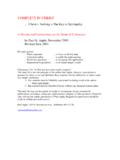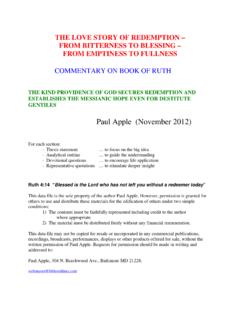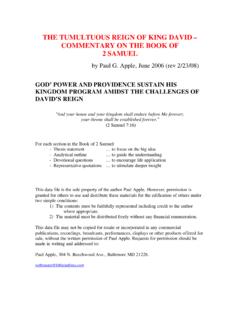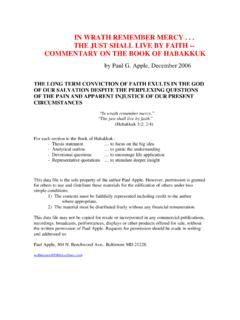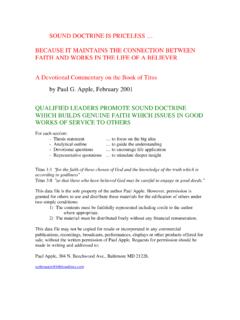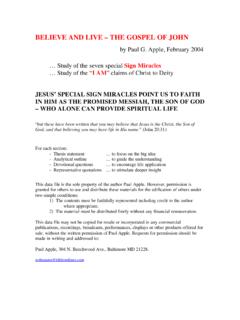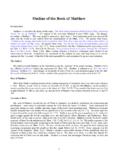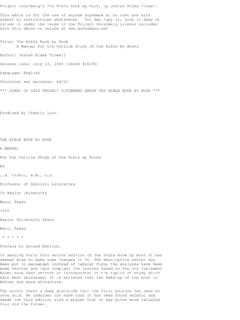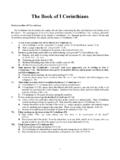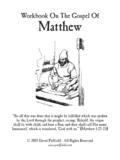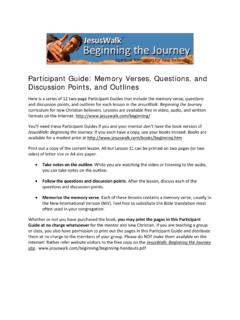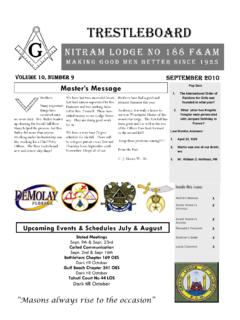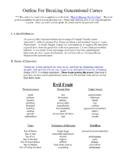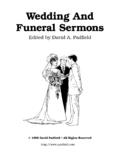Transcription of NINE TESTS OF GENUINE FAITH A Devotional …
1 NINE TESTS OF GENUINE FAITH A Devotional commentary on the book of James by Paul G. Apple, Revised April 2008 (with supplemental notes from Pastor Thomas Leake, Hope Bible Church) IN THE PRACTICAL REALITIES OF EVERYDAY LIFE, GENUINE FAITH EMBRACES FULLY THE WILL OF GOD For each section: - Thesis statement .. to focus on the big idea - Analytical outline .. to guide the understanding - Devotional questions .. to encourage life application - Representative quotations .. to stimulate deeper insight James 2:17 "Even so FAITH , if it has no works, is dead, being by itself." This data file is the sole property of the author Paul Apple. However, permission is granted for others to use and distribute these materials for the edification of others under two simple conditions: 1) The contents must be faithfully represented including credit to the author where appropriate. 2) The material must be distributed freely without any financial remuneration.
2 This data file may not be copied for resale or incorporated in any commercial publications, recordings, broadcasts, performances, displays or other products offered for sale, without the written permission of Paul Apple. Requests for permission should be made in writing and addressed to: Paul Apple, 304 N. Beechwood Ave., Baltimore MD 21228. ABOUT THE AUTHOR Paul majored in English at Princeton University and graduated in 1979 with a Master of Divinity degree from Grace Theological Seminary in Winona Lake, IN. He lives in the Baltimore area with his wife Karen. He has worked in management roles for several local companies while engaging in pastoring and preaching responsibilities at Solid Rock Community Church. His four children (and one daughter in law) enjoy a wide range of educational and professional pursuits while sharing in common a love for the Lord Jesus. BACKGROUND OF THE book OF JAMES Moore: "Jet Tour Through James" -- INTRODUCTION: James is a call to put FAITH to work.
3 Mere words will not do. Agreement with a particular creed in not enough. GENUINE FAITH will be displayed in a life that is increasingly maturing in Christ. We are saved by FAITH alone, but FAITH that saves is not alone. I. The Author of the book . A. 3 different James in the N. T. 1. James the son of Zebedee (Matt. 4:21; 10:2; Luke 5:10) 2. James the son of Alphaeus (Matt. 10:3; Acts 1:13) 3. James the son of Joseph & Mary { brother of Jesus} (Mat 13:55; Gal 1:19) B. Author = James the brother of Jesus; He 1. the oldest of Jesus brothers. (Mark 6:3) 2. an unbeliever prior to the resurrection.
4 (John 7:3-10) 3. among those Jesus appeared to after the resurrection, resulting in his conversion. (1 Cor 15:7) 4. with the disciples in the upper room awaiting the coming of the Holy Spirit on Pentecost. (Acts 1:14) 5. the 1st pastor of the Jerusalem Church. (Acts 12:17, 15:13, 19; Gal 2:1, 9, 10, 12) 6. married. (1 Cor 9:5) 7. humble; referring to himself not as brother of Jesus, but rather as a servant of Jesus. (Jas 1:1) 8. traditionally regarded as an unusually good man . 9. given the nickname the Just . 10. said to have had calluses on his knees from spending so much time in prayer. II.
5 The Recipients of the book . A. The 12 tribes (of Israel) scattered abroad (1:1) B. Jewish Christians (2:1) C. A General Epistle = circulated among several groups of Believers. III. The Date & Place of Writing. A. Date = 45 A. D. ; 1st NT book written B. Place = Jerusalem IV. The Purpose of the book . A. To show that true FAITH produces good works. B. To emphasize the practical aspects of Christian living. Stedman: "There has been considerable controversy as to whether James, the brother of Jesus, was the one who wrote the letter, but if you look carefully into its background, you can see that it almost certainly must be the Lord's brother who pens this letter. In the early days after the resurrection, he became the acknowledged leader of the church in Jerusalem, and was regarded by all with reverence and respect even by the Jews -- so that he gained the title, "James the just one.
6 " Tradition tells us, supported by Eusebius, one of the great church fathers and a respected historian, that James was finally martyred for his FAITH by being pushed off the pinnacle of the temple. The pinnacle was the point in the wall around the temple that jutted out over the Kidron Valley. There is a drop of about a hundred feet from the height of that wall straight down into the Eusebius tells us that in about the year 66 , James the Just, the brother of our Lord, was pushed off this pinnacle by the Jews who had become angered with him for his Christian testimony. Eusebius says that the fall did not kill him, and that he managed to stumble to his knees to pray for his murderers. So they finished the job by stoning him to death, and he joined the band of martyrs. Now it is very evident that this letter was written during the early part of the life of the church. It comes out of that period reflected in the book of Acts, and may therefore be the earliest Christian document that we have, written perhaps even before the gospels of Mark or Matthew.
7 You cannot read this letter of James without being struck by its likeness to the teaching of Jesus; in fact, if you take the Sermon on the Mount, and the letter of James, and lay them side by side, you'll see more than a dozen exact parallels. So, it is quite evident that this man James listened to the Lord Jesus and heard these messages, even though perhaps he struggled with them at the time. Also, this letter, more than any other letter in the New Testament, is characterized, like the teaching of the Lord himself, by figures of speech taken from nature. You have the waves of the sea, the animal kingdom, the forests, the fish, and others, all drawn from nature, just as the Lord Jesus himself used to do." Vaughan: "James is the most intensely practical book of the New Testament. There is, to be sure, a 'compressed theology' in James (cf. 1:1, 18, 21; 2:1, 5; 5:7, 9, etc.), but theological teaching is not the chief contribution of the book .
8 James is 'the epistle of practice,' the Amos of the New Testament. It rebukes all sham and hypocrisy, insisting that conduct must conform to creed, that profession must be matched by performance. From beginning to end it is an urgent demand for 'reality in religion.' James would surely have agreed with Bunyan that 'the soul of religion is the practical part.'" Wiersbe: "The Epistle of James was written to help us understand and attain spiritual maturity (1:4b).. James used the word perfect several times, a word that means 'mature, complete' (see 1:4, 17, 25; 2:22; 3:2). By 'a perfect man' (3:2) James did not mean a sinless man, but rather one who is mature, balanced, grown-up." Ken Boa: Talk Thru the New Testament: James is an intensely practical manual on the outworking of true FAITH in everyday life. It explores Christian conduct from several perspectives and shifts abruptly from topic to topic. FAITH perseveres under trials, resists temptation, responds to the Word, overcomes prejudice, produces good works, controls the tongue, manifests wisdom, submits to God rather than worldly pleasures, depends on God rather than wealth, and waits patiently for the return of the Lord.
9 Biblical FAITH moves from assent to actions, from words to works. Outline: I. Character of FAITH A. (1:1-12) Persevering under Trials Will B. (1:13-18) Progress of Temptation C. (1:19-27) Planting the Word Word D. (2:1-13) Personal Favoritism Works E. (2:14-26) Performance of FAITH II. Control of FAITH A. (3:1-12) Power of the Tongue Words B. (3:13-18) Portrait of Pure Wisdom Wisdom III. Conflicts of FAITH A. (4:1-12) Perversity of Pleasures Worldliness B. (4:13-5:6) Pride of the Rich Wealth IV. Consummation of FAITH A. (5:7-12) Patient Endurance Wait B. (5:13-20) Prayer and Restoration Wholeness Brian Racer: James = Christian Maturity Manual Outline: The FAITH Building Process Requires interaction along 2 fronts: both dynamics must be present and active: 1) Contact with unbelievers communicating our FAITH 2) Communion with Christ and His Church I. Commitment of FAITH II.
10 Confession of FAITH in Baptism III. Consecration of FAITH Rom. 12:1-2 IV. Character Development of FAITH growing up process; takes longer with some than others; God uses adversity in the form of TESTS to target those areas that don t look like Christ V. Completed / Mature FAITH now able to be a model for others; set an example; assume leadership; the more we look like Christ the better hearing we will receive from unbelievers Character of the book : James is called the Proverbs of the New Testament. James was obviously influenced by Proverbs of the Old Testament, the exhortative Psalms and the Sermon on the Mount. James writes with terse, pointed exhortations that call his audience to obedience. The book only references the person of Jesus on a couple occasions and does not develop any deep or new theological ground. That and the fact that James introduces the idea that FAITH must have works and seems to be an apparent contradiction to Paul s teaching of justification, caused Martin Luther to declare the book to be a right strawy epistle.
